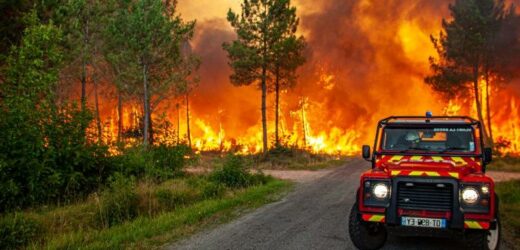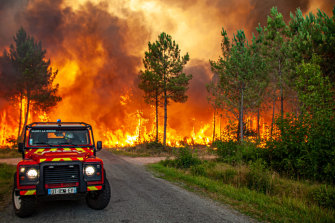South-eastern England looked for a time this week like a scene from south-eastern Australia in the midst of a long hot summer.
Fires sprang up in parched parks and fields and made their way through the suburbs into London. Drivers battled smoke and flames along motorways on the outskirts. Social media filled with emergency warnings in a manner that Australians know too well.
Fires burn out of control near Landiras, south of Bordeaux.Credit:AP
“London Fire Brigade has just declared a Major Incident in response to a huge surge in fires across the capital today,” tweeted London Lord Mayor Sadiq Khan as the blazes spread through the capital.
“This is critical: @LondonFire is under immense pressure. Please be safe. I’m in touch with the Commissioner and will share updates when I have them.”
This followed Britain’s Met Office confirming that, as temperatures surged on Tuesday, a provisional temperature of 40.2 degrees had been recorded at Heathrow, smashing historical records.
“It’s virtually impossible for the UK to experience 40 C in an undisrupted climate. But climate change, driven by greenhouse gases, has made these extreme temperatures possible – and we’re actually seeing that possibility now,” Stephen Belcher, the chief scientist of the Meteorological Office, said in a video statement.
Inside a region that spread across much of France, Germany and Britain, temperatures hovered at nearly 7 degrees above average.
The tumbling temperature records, the fires, the collapsed glaciers, closed schools, buckled train tracks and melted runways have offered us a terrifying glimpse of life in a world that is now 1.1 degrees warmer than it was at the start of the industrial era. The science tells us that no matter how quickly governments act on climate, for most people alive today this will be the coolest climate they experience.
But this is just one unnerving aspect of Europe’s horror summer.
The other is that it is biting just as fragile global consensus that had emerged on tackling climate change is fraying.
In January last year when the new Democratic administration began, the United States immediately rejoined the Paris Agreement and US President Joe Biden threw the weight of the US State Department, perhaps still the world’s most powerful diplomatic machine, into driving the global effort forward.
By the time climate talks in Glasgow began last November the UK, the EU and the US, which is to say the economies most responsible for climate change due to their historical emissions, had set goals enshrined to cut emissions in half by 2030.
They led an effort that saw the rest of the world sign up to emission reduction targets, and helped forge an agreement that would see wealthier nations assist emerging economies to pay for a rapid transition.
There was – is – a strong argument that the commitments were too little, too late to keep the world from warming to 1.5 degrees, as was the stated goal, but diplomatic consensus was significant.
Now, seven dismal months into 2022, Glasgow looks increasingly like a high point.
Earlier this month the European Parliament backed an EU plan to classify gas a climate friendly energy source rather than the dangerous warming agent that it is, so desperate is the region to replace Russian gas supplies.
The purpose is to reduce finance costs for new gas developments. The effect will be to prolong gas use in the region and make its emission reduction targets harder to meet.
Meanwhile, in the US the recalcitrant Democratic senator Joe Manchin – a man whose personal and political fortune rests upon coal – has finally torpedoed what little hope Biden had of passing the bulk of his own ambitious climate measures, ending 18 months of negotiations for his crucial vote.
“We are not going to meet our targets, period,” environmental scientist Leah Stokes, who has advised congressional Democrats on climate legislation, told The New York Times on Friday of Manchin’s position. “I honestly don’t know how he is going to look his own grandchildren in the eyes.”
Manchin’s spokesman told The Washington Post that his boss believed the White House needed to adjust its vision to new economic realities.
Maybe. But what about climate realities? The climate crisis may have been over a century in the making and its solution will take generations of concerted effort, but its impacts are now even more plainly immediate.
A guide to the environment, what’s happening to it, what’s being done about it and what it means for the future. Sign up to our fortnightly Clear Air newsletter here.
Most Viewed in Environment
From our partners
Source: Read Full Article



